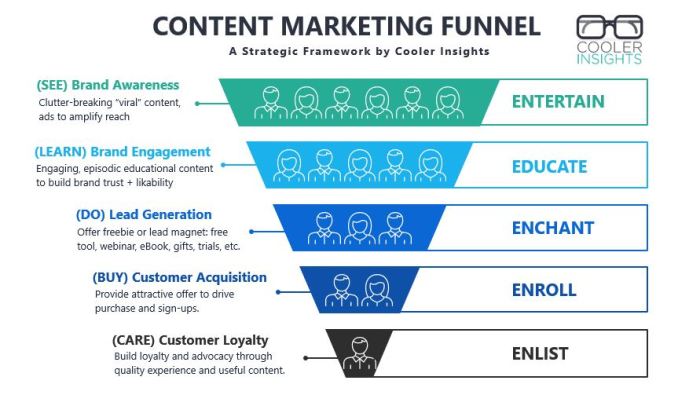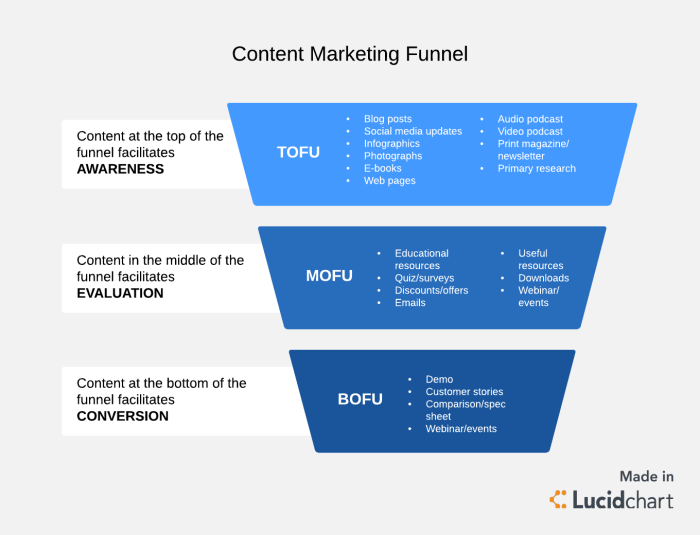Developing a Content Marketing Funnel takes center stage as we dive into a world of strategic planning and creative content creation, all aimed at driving customer engagement and boosting conversions.
This comprehensive guide unravels the intricacies of each stage of the funnel, providing actionable insights and real-world examples to help you master the art of content marketing.
Overview of Content Marketing Funnel
A content marketing funnel is a strategic approach to guide potential customers through the buying journey by providing them with valuable content at each stage of the funnel. It involves creating and distributing relevant and engaging content to attract, engage, and convert leads into customers.
Importance of Having a Well-Developed Content Marketing Funnel
Having a well-developed content marketing funnel is crucial for businesses to effectively nurture leads and drive conversions. It helps in building brand awareness, establishing credibility, and fostering relationships with customers. By delivering targeted content to prospects based on their needs and interests, businesses can increase engagement and loyalty, ultimately leading to higher sales and revenue.
Examples of Successful Content Marketing Funnels in Different Industries
- In the e-commerce industry, companies like Amazon use personalized product recommendations and targeted email campaigns to guide customers through the purchase journey.
- In the SaaS (Software as a Service) industry, companies like HubSpot provide valuable resources such as blogs, webinars, and case studies to educate prospects and demonstrate the value of their software solutions.
- In the healthcare industry, organizations like Mayo Clinic create informative content such as articles, videos, and infographics to educate patients and build trust in their medical expertise.
Stages of a Content Marketing Funnel: Developing A Content Marketing Funnel
In a content marketing funnel, there are four main stages that potential customers go through: awareness, consideration, conversion, and retention. Each stage requires a different approach to create content that resonates with the audience and moves them further down the funnel.
Awareness Stage
At the awareness stage, the goal is to attract the attention of potential customers and make them aware of your brand. Content types suitable for this stage include:
- Blog posts
- Social media posts
- Infographics
To tailor content for the awareness stage, focus on creating engaging and informative content that addresses common pain points or challenges faced by your target audience. Use catchy headlines and visuals to grab attention and encourage further exploration.
Consideration Stage
During the consideration stage, potential customers are evaluating your products or services. Content types suitable for this stage include:
- Case studies
- Product demos
- Comparison guides
To tailor content for the consideration stage, provide detailed information about your offerings and how they can solve the specific needs of the audience. Highlight the unique selling points of your products or services to differentiate yourself from competitors.
Conversion Stage
The conversion stage is where potential customers make a purchase decision. Content types suitable for this stage include:
- Testimonials
- Free trials
- Discount offers
To tailor content for the conversion stage, focus on building trust and credibility with the audience. Use customer testimonials and reviews to showcase the positive experiences of past customers and encourage conversions.
Retention Stage
In the retention stage, the goal is to keep customers engaged and coming back for more. Content types suitable for this stage include:
- Email newsletters
- Customer success stories
- Exclusive offers for existing customers
To tailor content for the retention stage, focus on providing value and building long-term relationships with customers. Offer personalized content and special promotions to reward loyalty and encourage repeat business.
Creating Content for the Top of the Funnel
When it comes to creating content for the top of the marketing funnel, the focus should be on generating awareness and capturing the attention of a broader audience. By implementing the right strategies and optimizing content for search engines, businesses can attract potential customers and guide them towards the next stages of the funnel.
Strategies for Creating Awareness-Stage Content, Developing a Content Marketing Funnel
To create effective awareness-stage content, businesses should focus on providing valuable information that addresses the needs and interests of their target audience. This content should be educational, engaging, and easily digestible. Some strategies to consider include:
- Utilizing social media platforms to share informative posts and engage with followers.
- Creating blog posts, articles, or videos that answer common questions or provide solutions to problems.
- Collaborating with influencers or industry experts to reach a wider audience and build credibility.
Attracting a Wider Audience Through Content
Attracting a wider audience through content requires businesses to understand their target market and tailor their messaging accordingly. By conducting research, creating compelling headlines, and utilizing visual content, businesses can increase their visibility and attract more visitors to their website. Additionally, engaging with online communities, participating in discussions, and leveraging email marketing can help expand the reach of the content.
Optimizing Content for Search Engines at the Top of the Funnel
Optimizing content for search engines at the top of the funnel involves incorporating relevant s, meta tags, and descriptions to improve visibility and organic search rankings. Businesses should focus on creating high-quality, original content that provides value to the audience while also being optimized for search engines. By conducting regular audits, monitoring performance metrics, and experimenting with different strategies, businesses can refine their content and attract a steady flow of organic traffic.
Nurturing Leads in the Middle of the Funnel

When it comes to guiding leads through the consideration stage in the middle of the funnel, it’s crucial to provide them with valuable and relevant content that addresses their specific needs and pain points. This is the stage where prospects are evaluating different options and are looking for more in-depth information to help them make a decision.
Methods for Guiding Leads
- Personalized Email Campaigns: Sending targeted emails based on the prospect’s behavior and interactions with your brand can help nurture leads and move them closer to a purchase decision.
- Webinars and Workshops: Hosting informative webinars or workshops that provide valuable insights and solutions to common problems can establish your brand as a trusted resource.
- Case Studies and Testimonials: Sharing success stories from satisfied customers can help build credibility and trust with leads who are considering your products or services.
Examples of Content
- Comparison Guides: Creating side-by-side comparisons of your product or service with competitors can help prospects evaluate their options more effectively.
- Product Demos: Offering virtual or in-person product demonstrations can give leads a firsthand look at how your offering can solve their problems.
- Expert Interviews: Conducting interviews with industry experts or thought leaders can provide valuable insights and perspectives that can influence purchase decisions.
Building Trust and Credibility
- Consistent Messaging: Ensure that your brand’s messaging is consistent across all channels to build trust and credibility with leads.
- Transparency: Be transparent about your products or services, pricing, and customer reviews to establish trust with prospects.
- Responsive Customer Service: Providing excellent customer service and support can go a long way in building trust and credibility with leads in the middle of the funnel.
Converting Leads at the Bottom of the Funnel
To convert leads into customers at the bottom of the funnel, you need to focus on providing valuable content that addresses their specific needs and concerns. This is the stage where potential customers are ready to make a purchase decision, so your content should be persuasive and informative to push them towards that final step.
Role of Content in Conversion
Creating content that highlights the unique selling points of your product or service is crucial at this stage. Use case studies, testimonials, and product demos to showcase the benefits and value that your offering provides. By demonstrating how your solution can solve their problems or improve their lives, you can convince leads to take the next step.
- Utilize targeted content: Tailor your content to address the pain points and objections of leads at the bottom of the funnel.
- Provide social proof: Include testimonials, reviews, and success stories to build trust and credibility with potential customers.
- Offer incentives: Use special discounts, free trials, or limited-time offers to encourage leads to make a purchase.
Creating Compelling Calls-to-Action
A strong call-to-action (CTA) is essential to guide leads towards converting into customers. Your CTAs should be clear, specific, and compelling to prompt action from your audience. Here are some tips for creating effective CTAs:
- Use action-oriented language: Start your CTA with a verb to encourage immediate action, such as “Buy Now” or “Sign Up Today.”
- Create a sense of urgency: Include words like “Limited Time Offer” or “Act Now” to convey a sense of urgency and prompt immediate action.
- Make it visually appealing: Use contrasting colors, bold fonts, and strategically placed buttons to make your CTA stand out on the page.
Analyzing and Optimizing the Content Marketing Funnel

When it comes to analyzing and optimizing the content marketing funnel, there are key metrics that you need to track at each stage to ensure success. By understanding the data and performance of your funnel, you can make informed decisions to improve your overall marketing strategy.
Key Metrics to Track at Each Stage of the Funnel
- Top of the Funnel (TOFU):
- Website Traffic
- Engagement Rate
- Click-Through Rate (CTR)
- Middle of the Funnel (MOFU):
- Lead Quality
- Email Open Rates
- Content Consumption
- Bottom of the Funnel (BOFU):
- Conversion Rate
- Sales Revenue
- Customer Lifetime Value
Discuss the Importance of Analyzing Data to Optimize the Funnel
Analyzing data throughout the content marketing funnel is crucial for identifying strengths and weaknesses in your strategy. By closely monitoring key metrics, you can pinpoint areas that need improvement and make data-driven decisions to optimize your funnel for better results.
Examples of Tools and Software for Monitoring and Improving Funnel Performance
- Google Analytics: Provides in-depth website data and audience insights to track performance at each stage of the funnel.
- HubSpot: Offers a comprehensive platform for managing leads, tracking engagement, and analyzing funnel performance.
- Crazy Egg: Helps visualize user behavior on your website with heatmaps and click-tracking to optimize conversion paths.






